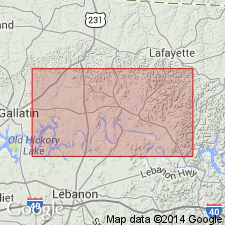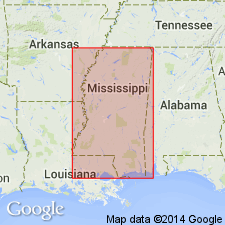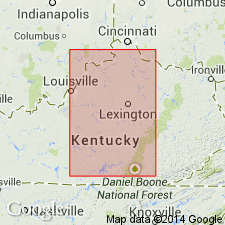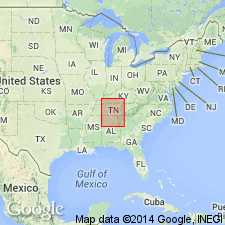
- Usage in publication:
-
- Trousdale shale
- Modifications:
-
- Overview
- AAPG geologic province:
-
- Cincinnati arch
Summary:
The black shales of central TN that were formerly called "Chattanooga" compose two formations of Lower Mississippian (Kinderhookian) age, separated by widespread erosional unconformity, and locally, one formation of Late Devonian age. The upper of the Mississippian shales correlates by physical and faunal evidence with Sunbury shale of OH and KY, and the lower Mississippian shale correlates with Cleveland shale of OH and KY. The Upper Devonian black shale (which contains Genesee-Portage fossils) is present in northern part of State only, and is physically associated with fossiliferous Devonian limestones. The name Trousdale shale has been suggested for it.
Source: GNU records (USGS DDS-6; Reston GNULEX).

- Usage in publication:
-
- Trousdale shale
- Modifications:
-
- Named
- Dominant lithology:
-
- Shale
- AAPG geologic province:
-
- Cincinnati arch
Summary:
Name Trousdale shale is here tentatively proposed for the Genesee equivalent in TN. The study of presence of Genesee deposits in TN is in progress.
Source: GNU records (USGS DDS-6; Reston GNULEX).

- Usage in publication:
-
- Trousdale shale
- Modifications:
-
- Areal extent
- AAPG geologic province:
-
- Cincinnati arch
Summary:
Basal bed of New Albany shale in KY contains abundant SCHIZOBOLUS CONCENTRICUS Vanuxem through its entire thickness and is without LEIORHYNCHUS assemblage that occurs above SCHIZOBOLUS in IN. This change in faunal content becomes evident just south of the Ohio River. SCHIZOBOLUS shale prevails in KY and TN where it was described and named Trousdale shale by Pohl (1930). Since there is no apparent difference in this layer in the two areas, bed in KY is identified here as Trousdale. The Trousdale extends around Cincinnati Arch to Olympian Springs where it pinches out and extends southward into TN. Has uniform thickness of about 10 ft. Overlies Portwood formation (new), where Portwood is present, and Hamilton limestone elsewhere. Overlain everywhere by Blackiston formation (new), and where contact is within the black shale of the two formations, the boundary can be approximately located by fossils in the Trousdale and can be determined definitely when joints in the two strata are exposed. From Estill Co., KY, northward, the Olentangy shale, basal member of Blackiston, rests on Trousdale. In TN, Trousdale lies below Dowelltown formation (new) of Chattanooga.
Source: GNU records (USGS DDS-6; Reston GNULEX).

- Usage in publication:
-
- Trousdale formation
- Modifications:
-
- Not used
- AAPG geologic province:
-
- Cincinnati arch
Summary:
Name Trousdale formation not used in this report as rocks are here considered to be part of the Dowelltown member of the Chattanooga shale.
Source: GNU records (USGS DDS-6; Reston GNULEX).
For more information, please contact Nancy Stamm, Geologic Names Committee Secretary.
Asterisk (*) indicates published by U.S. Geological Survey authors.
"No current usage" (†) implies that a name has been abandoned or has fallen into disuse. Former usage and, if known, replacement name given in parentheses ( ).
Slash (/) indicates name conflicts with nomenclatural guidelines (CSN, 1933; ACSN, 1961, 1970; NACSN, 1983, 2005, 2021). May be explained within brackets ([ ]).

